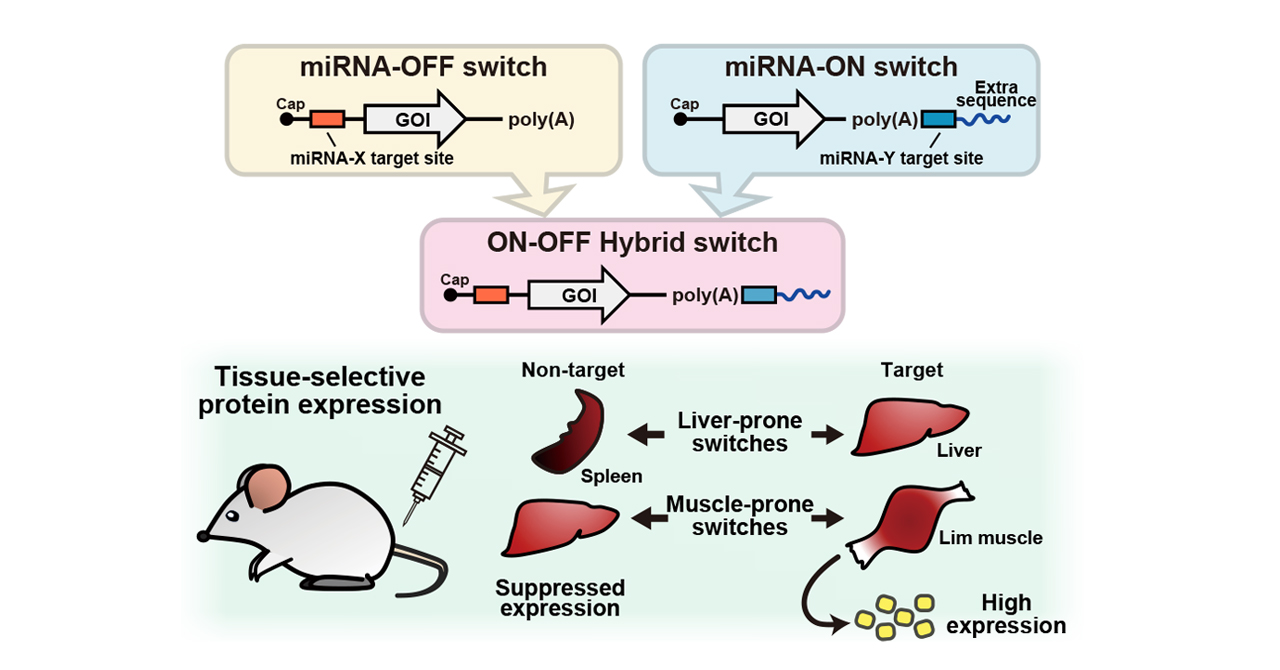
News & Events
News & Events
News
July 07, 2025
Integrating ON-OFF switches for targeted mRNA therapeutics
Messenger RNA (mRNA) therapeutics offer a promising platform for treating diseases by enabling protein production without altering the DNA in our cells. Central to this process is translation, in which the cell reads the mRNA's instructions to build proteins using its internal machinery. The study introduces a novel ON-OFF hybrid mRNA switch that precisely controls protein production by detecting naturally occurring microRNAs (miRNAs)—small molecules that help regulate gene activity and are often unique to specific tissues.
The new hybrid switch combines two functions: an ON-switch that activates protein production when it detects miRNAs found in target cells and an OFF-switch that shuts down production when it detects miRNAs from non-target cells. This dual system vastly improves the ability to control where desired proteins are produced, thus reducing unwanted effects in the wrong tissues.
To fine-tune the ON-switch, the researchers tested different short sequences added after the poly(A) tail—a string of "A" letters at the end of the mRNA that helps stabilize the molecule and ensures proper recognition by the cell. The team found that a specific U-rich sequence (UUUA repeated six times, followed by a short stretch of Us) worked best to keep the switch off when the target miRNA was absent, while turning it on when the miRNA was present.
They then engineered a single mRNA molecule containing both ON and OFF elements. In experiments with human cells, the hybrid switch clearly distinguishes between different cell types based on their miRNA profiles, achieving up to 16 times more protein production in target cells than in non-target cells.
The team also tested the switch in live mice. By injecting mRNA into muscles or veins, they showed that the hybrid switch could direct protein production in specific tissues, such as muscle or liver, depending on the miRNAs present. This is the first time such a system has been shown to work in living animals using natural miRNAs.
Overall, this hybrid mRNA switch represents a powerful and flexible tool for future mRNA-based treatments, thus permitting precise control over where therapeutic proteins are made. While some challenges remain—such as boosting protein levels in target tissues—the approach marks a major step forward in making mRNA therapies safer and more effective.

Graphical abstract
Paper Details
- Journal: Molecular Therapy Nucleic Acids
- Title: MicroRNA-Responsive ON-OFF Hybrid mRNA Switch for Precise Protein Expression Control
- Authors: Kaito Masaki1,2, Yoshihiko Fujita1, Hirohide Saito1,3*
*: Corresponding author - Author Affiliations:
- Center for iPS Cell Research and Application, Kyoto University
- Graduate School of Medicine, Kyoto University
- Institute for Quantitative Biosciences, The University of Tokyo






















